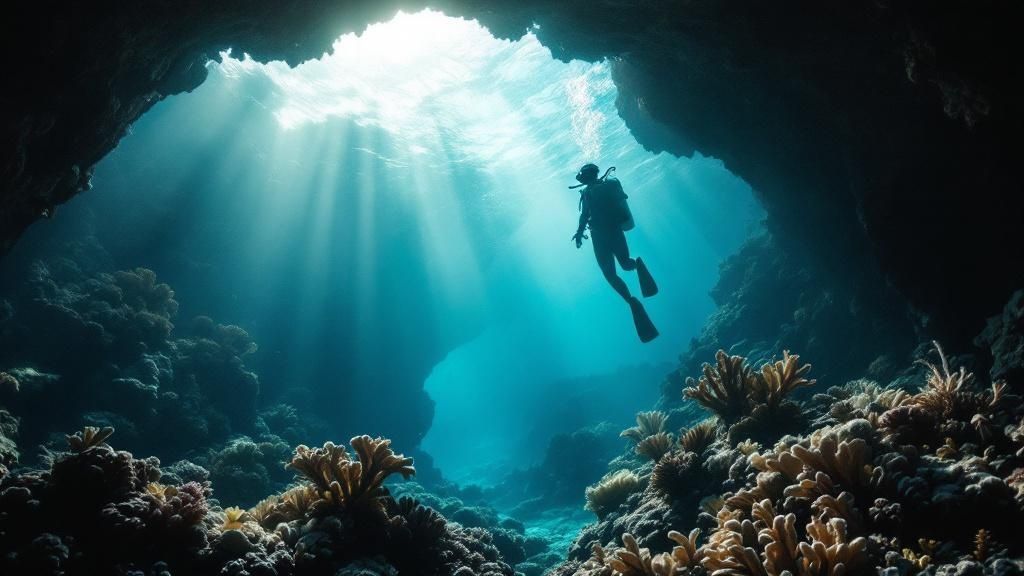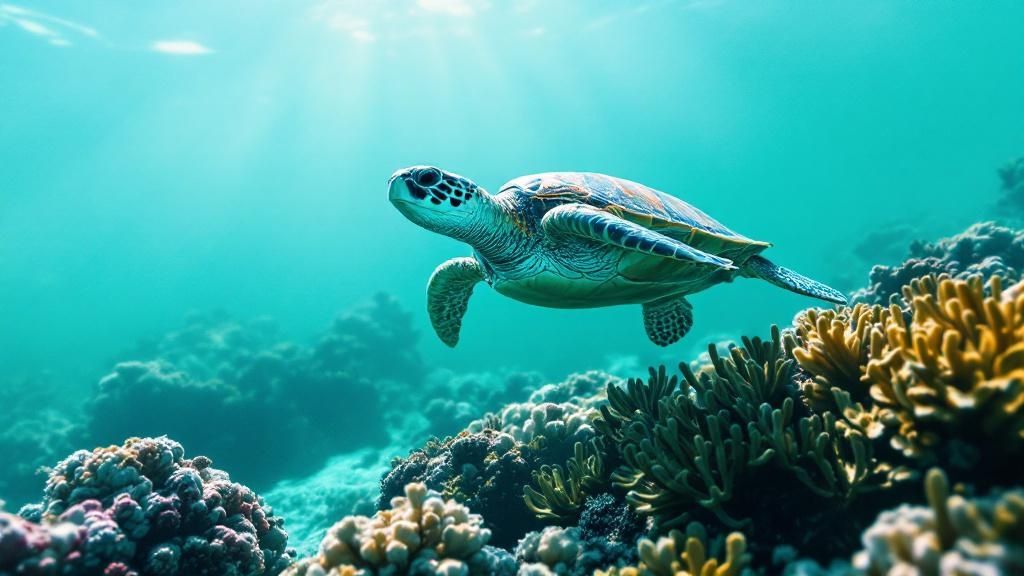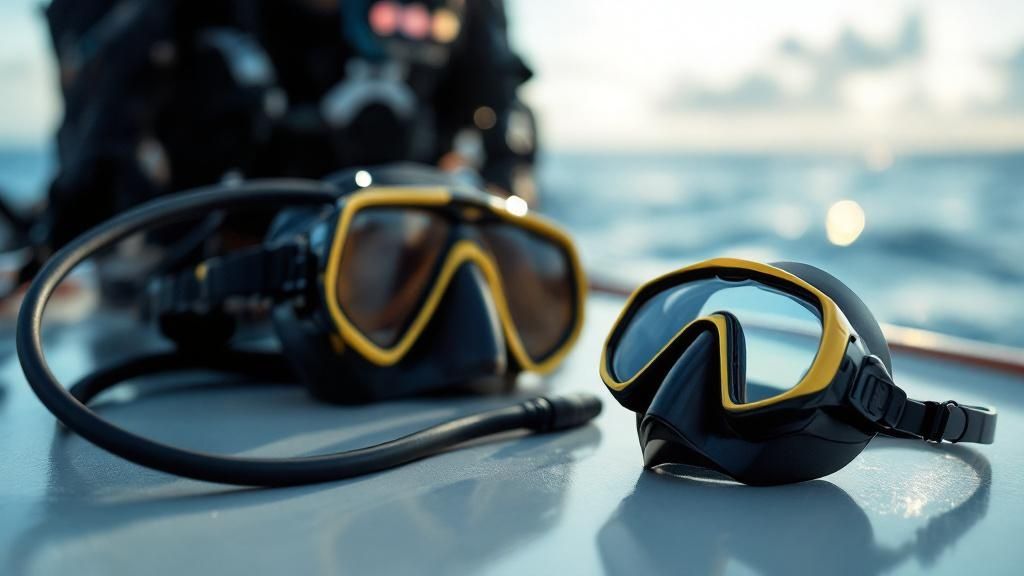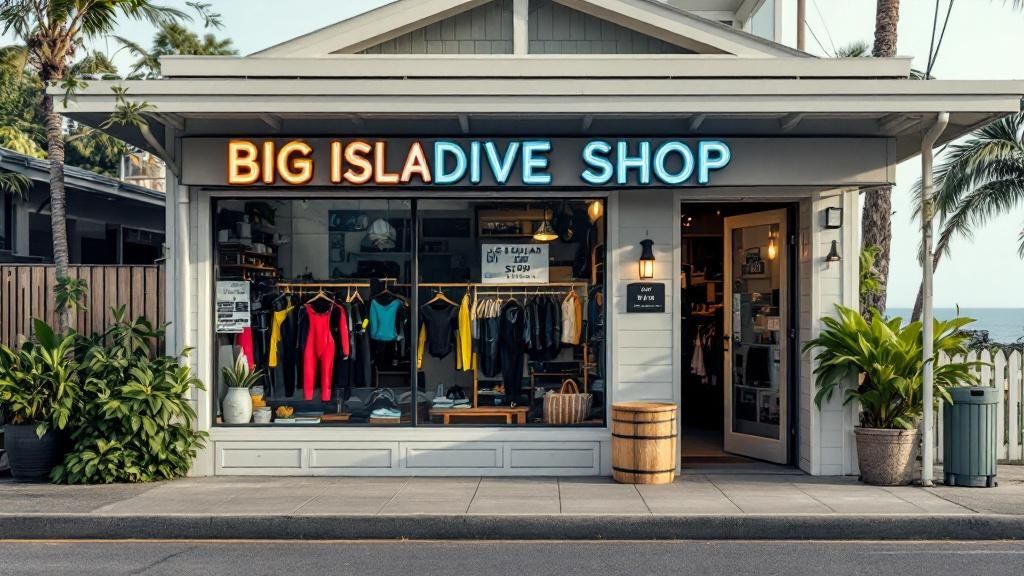Picture this: you’re drifting weightlessly through impossibly clear water, watching sunlight dance through the openings of an ancient lava tube. A moment later, a majestic honu (green sea turtle) glides past, completely unbothered by your presence. This isn’t a dream. This is what it’s like to go Big Island scuba diving. It’s an adventure that tops the bucket list for divers all over the world, and for very good reason.
Why The Big Island Is a Diver's Paradise
So, what makes the Big Island diving scene so different from other tropical spots? It all comes down to the island's dramatic volcanic past. The same forces that shaped the massive volcanoes above the water also created a breathtaking underwater world. Below the waves, you’ll discover a landscape carved by ancient lava flows, leaving behind a playground of tunnels, massive arches, and stunning caverns you simply won’t find anywhere else.
This one-of-a-kind underwater landscape is a direct gift from the island’s volcanoes. Kona, in particular, has earned its reputation as a global scuba paradise because of these features and its crystal-clear water. Since the coast is sheltered from the wind, the ocean stays calm for most of the year, with visibility that often pushes past 100 feet. It’s a surreal experience, especially when you’re exploring the famous "Cathedrals"—huge lava tubes where beams of sunlight cut through the darkness like spotlights from another world.

The Magic of the Kona Coast
The secret ingredient to the island’s incredible diving is the Kona coast. Tucked away on the leeward side, it’s shielded from the gusty trade winds by the colossal volcanoes of Mauna Loa and Hualalai. This natural barrier means the water here is remarkably calm and clear pretty much all year long. This makes Kona diving perfect for everyone, whether you’re taking your first breath underwater or you're a seasoned pro with hundreds of dives logged. The calm conditions allow delicate coral reefs to flourish, which in turn support an unbelievable amount of marine life.
These healthy reefs are teeming with a spectacular variety of creatures. On any given dive, you’re likely to run into:
- Honu (Green Sea Turtles): Often spotted munching on algae or just chilling out on the reef.
- Spinner Dolphins: Famous for their acrobatic jumps above the water, they’re just as curious and playful below it.
- Reef Sharks: You'll commonly see white-tip reef sharks, which are quite relaxed and pose no threat to divers.
- Vibrant Reef Fish: Swirling schools of yellow tangs, parrotfish, and butterflyfish paint the reef in a riot of color.
Diving in Kona is like exploring a completely different planet. The mix of ancient volcanic structures and the sheer abundance of sea life is an experience that sticks with you long after you’ve dried off.
Ultimately, scuba diving Big Island Hawaii is all about variety. One day you could be navigating a pitch-black lava tube, and the next you could be watching the world-famous manta ray night dive—a truly unforgettable ballet we'll get into later. For a deeper look at all the possibilities, check out our full guide to Big Island scuba diving experiences. Whether you’re looking for high adventure with the top Kona diving companies or just a peaceful swim with the fishes, the diving Hawaii Big Island scene has you covered.
Exploring the Top Big Island Dive Sites
So, you’re ready to get wet. Let's talk about the spots that make the Big Island a bucket-list destination for divers worldwide. This isn’t just a list; it’s a peek into what you’ll actually see and feel when you descend into the blue. The island's west coast, from Kona down to Kealakekua, is a spectacular playground of pristine coral gardens and dramatic volcanic landscapes.
Every dive site here has its own personality. It's what makes scuba diving Big Island so special. You might spend one dive gliding through an ancient lava tube and the next watching sea turtles line up for a cleaning. Knowing what each spot offers is the key to crafting that perfect underwater trip.

Kealakekua Bay: The Crown Jewel
You simply can't talk about Kona diving without starting at Kealakekua Bay. Most people know it as the place where Captain Cook first landed, but for us divers, the real history is written in the reef below.
The bay is a legally protected Marine Life Conservation District, and you can tell. It’s teeming with life. The reason it’s such a premium spot is the combination of calm, clear water and stunning biodiversity. Visibility often clears 100 feet, and because it's sheltered from the open ocean, conditions are almost always placid—perfect for new and experienced divers alike. The hard and soft coral gardens are vibrant, supporting massive schools of yellow tangs, parrotfish, and more.
And while you're in the area, remember that the bay is also famous for incredible Captain Cook underwater adventures like snorkeling, which offers a beautiful, top-down view of the reef's magic.
Dramatic Arches and Playful Turtles
Once you move beyond the bay, the coastline reveals some truly unique sites that scream "Big Island." These spots are all about the island's volcanic soul and the amazing creatures that call it home.
- Golden Arches: Just like the name implies, this site is built around a massive lava rock arch you can swim right through. It's a photographer's dream and a great place to find eels and octopuses tucked into the rockwork.
- Turtle Pinnacle: This is what we call a “cleaning station.” It's a specific spot where Hawaiian green sea turtles (honu) come to let smaller fish nibble algae and parasites off their shells. You're almost guaranteed to see several turtles just hanging out.
- Suck 'em Up: A bit of a thrill ride for more advanced divers. This cavern has a surge channel that gently pulls you in and pushes you back out with the swell. It’s a rush and a powerful reminder of the ocean's energy.
Witnessing the Manta Ray Night Dive

If there's one single experience that defines Big Island diving, it has to be the world-famous manta ray night dive. Honestly, calling it just a "dive" doesn't do it justice. It’s more like a silent, underwater ballet that feels completely out of this world.
The whole adventure kicks off with a sunset cruise along the Kona coast as the sky puts on a show of fiery colors. Then, as true darkness falls, you make your descent to the ocean floor.
Your group settles into a semi-circle on the sand, all pointing your dive lights up into the water column. These beams of light are the dinner bell, attracting swarms of microscopic plankton. And what happens next is pure magic.
First, a shadow emerges from the inky blackness. Then another, and another. Suddenly, giant manta rays, some with wingspans stretching up to 16 feet, are gliding effortlessly into the light. They perform somersaults and barrel rolls, scooping up plankton just inches from your mask. It’s a hypnotic, powerful, and deeply moving spectacle. No trip for scuba diving Big Island Hawaii is complete without it.
The Science and Sustainability Behind the Spectacle
This incredible encounter isn't just a happy accident. It's a well-understood phenomenon that local Kona diving companies have thoughtfully turned into a sustainable, world-class attraction. It all began when coastal hotels noticed their lights were attracting plankton, which in turn drew in the mantas. Dive operators simply learned how to replicate this effect out on the reef in a controlled and respectful way.
The iconic manta ray night dive has become a cornerstone of the island's tourism, bringing in thousands of visitors every single year. In fact, Kona dive shops lead over 25,000 dives annually just for this one experience. It's also been a massive win for science, giving researchers consistent and predictable access to the local manta population for identification and conservation work.
Of course, all responsible operators follow strict guidelines to ensure the safety and well-being of these gentle giants. The rules are simple, but they're absolutely crucial.
The core principle is passive observation. You are a guest in their dining room. By remaining still and keeping your hands to yourself, you allow the mantas to feel safe and continue their natural feeding behavior undisturbed.
This commitment to ethical diving ensures the diving Hawaii Big Island manta experience will be around for generations of divers to enjoy. For a complete guide on what to expect, check out our deep dive on the manta ray night dive in Kona.
Tips for an Unforgettable Manta Encounter
To get the absolute most out of your scuba Big Island manta dive, a little preparation makes a huge difference. Following these tips helps ensure you have a safe, comfortable, and truly magical experience.
- Stay Still: Find a good spot on the sandy bottom and make yourself comfortable. The less you move around, the closer the mantas will feel comfortable coming.
- No Touching: Manta rays have a protective mucus layer on their skin. Touching them can strip this off, leaving them vulnerable to nasty infections. Look, but don't touch.
- Control Your Buoyancy: Nailing your buoyancy is key here. You want to be neutrally buoyant just off the seafloor, creating a stable and non-intrusive viewing platform.
- Listen to Your Guide: Your divemaster is the expert on this interaction. Follow their briefing and instructions to the letter—it's for your safety and the well-being of the mantas.
This amazing diving Big Island adventure is waiting for you.
Planning Your Perfect Dive Trip
A truly epic Big Island scuba diving trip doesn't just happen by accident—it’s born from a bit of smart planning. This guide will walk you through piecing together a flawless scuba diving Big Island Hawaii adventure, so you’re ready for whatever the underwater world throws your way. Honestly, a little prep work, from timing your visit to picking your gear, makes all the difference.
The first big question is when to come. The great news? Kona diving is fantastic all year long, thanks to the calm, protected waters along the leeward coast. But, different seasons do offer slightly different vibes. It really comes down to what you're looking for: warmer water or the chance for some truly unique marine life encounters.

Timing Your Big Island Dive Adventure
Summer and fall, think roughly June through October, bring the toastiest water temperatures, often hovering around a blissful 80°F (27°C). This is peak comfort season. The seas are typically flat as a pancake and the visibility is amazing, making it the perfect time to visit if you tend to get chilly.
Winter and spring, from November through May, see the water cool off just a tad to about 75°F (24°C). It's still plenty comfortable, especially with a standard 3mm wetsuit. But this season holds a magical secret: it's humpback whale season. From December to April, the hauntingly beautiful songs of male humpbacks become the soundtrack to your dives. Hearing that underwater is an absolutely unforgettable part of any diving Hawaii Big Island experience.
To make it simple, here’s a quick look at the Big Island's diving seasons to help you plan your ideal trip.
Big Island Diving Seasons At A Glance
| Season | Water Temperature (Avg) | Key Marine Life Sightings | Pros |
|---|---|---|---|
| Summer/Fall (Jun-Oct) | 80°F (27°C) | Reef sharks, dolphins, turtles | Warmest water, calmest seas, best for comfort. |
| Winter/Spring (Nov-May) | 75°F (24°C) | Humpback whales (song), turtles | The chance to hear humpback whales underwater. |
Ultimately, no matter when you visit, the conditions for scuba Big Island diving are consistently top-notch. The choice is really between bathtub-warm water or the chance to listen to whale songs while you explore the reefs.
To Pack Or To Rent Your Gear
Next up: gear. Figuring out what to pack versus what to rent from Kona diving companies is a smart move that can save you a lot of hassle and extra baggage fees.
Here are a few pointers from my own experience:
- Pack these essentials: Your dive computer and your mask are non-negotiable. A mask that fits your face perfectly is crucial for a good time, and being familiar with your own computer is a huge safety plus. Don't leave home without them.
- Consider renting: Regulators, BCDs (buoyancy control devices), and wetsuits are big, bulky, and heavy. Trust me, lugging them across the Pacific is no fun. Reputable shops like Kona Honu Divers have high-quality, well-maintained rental gear ready to go.
- Nitrox is a game-changer: If you're certified, you should absolutely dive with operators that offer free Nitrox. This higher-oxygen blend can give you more bottom time and leave you feeling less tired, letting you squeeze every last drop of fun out of your diving Big Island vacation.
Choosing the right dive operator is probably the most important decision you'll make. A great company does more than just take you to a dive site; they elevate the whole experience with their local knowledge, commitment to safety, and genuine love for the ocean. For a deep dive into what makes a great operator, check out our complete guide to scuba diving on the Big Island of Hawaii. It's packed with tips to help you pick a crew that will make your trip memorable for all the right reasons.
How To Choose the Right Kona Dive Company
Picking the right dive operator for your Big Island diving trip can feel like a huge decision, and honestly, it is. The company you choose can absolutely make or break your entire underwater experience. A great operator doesn’t just shuttle you to a dive site; they elevate the whole adventure with top-notch safety, comfort, and a deep, personal knowledge of the local waters.
Think of it like hiring a guide for a mountain trek. You wouldn't just grab anyone who knows the main trail. You'd want the person who understands the fickle weather patterns, knows the secret viewpoints, and puts your safety above everything else. The exact same logic applies to Kona diving companies.

Safety and Certifications First
Your first and most important filter should always be safety. Full stop. A reputable dive company will be proud to show off its affiliations with major certification agencies like PADI or SSI. These aren’t just fancy logos; they’re a commitment to internationally recognized standards for training and safety.
Beyond the patches, look for an operator with a squeaky-clean safety record. This is a direct reflection of their daily discipline and the crew's experience. The best outfits run thorough pre-dive briefings, keep their gear in pristine condition, and have comprehensive first aid and oxygen kits on every single boat. Don't ever feel shy about asking about their safety protocols.
A great dive company doesn’t just meet the minimum safety standards—they live and breathe a culture of safety. From the captain down to the divemasters, every single crew member should be laser-focused on creating a secure and comfortable environment for every diver.
The Value of Small Groups and Expert Guides
Once you've checked the safety box, the next thing that separates a good trip from a truly great one is the diver-to-guide ratio. When you’re diving Big Island, you want a personal experience, not to feel like just another fin in a massive crowd.
Zero in on operators that run small-group charters. A smaller group size means a world of difference:
- More Personal Attention: Your guide has the bandwidth to offer you individual tips and point out that camouflaged octopus you would have otherwise missed.
- Less Impact on the Reef: Fewer divers in the water at one time is simply better for protecting the fragile coral ecosystems.
- A More Relaxed Vibe: Small boats just have a friendlier, more communal feel, where you can actually chat and connect with your fellow divers.
And the guides? They are your ticket to unlocking the magic of each dive site. A seasoned local guide knows the currents like the back of their hand, understands the behavior of the marine life, and can show you the secret nooks and crannies where the coolest creatures hide. Their passion is infectious and will make every minute of your scuba Big Island adventure richer.
For a more detailed breakdown, you might want to check out our guide to the top-rated Kona dive shops and what sets them apart.
Comfort and Amenities
Finally, don't forget about the boat itself. After an amazing dive, it's the little comforts that can make a huge difference in your day. Does the boat have snacks and drinks to help you refuel? Is there a shady spot to relax and get out of the intense Hawaiian sun?
One of the most-loved amenities, believe it or not, is a hot freshwater shower on board to rinse off all that salt. It’s a simple luxury, but it makes the boat ride back to the harbor so much more pleasant. These little details show that an operator truly cares about your entire experience—both in and out of the water. Choosing a company that thinks about these comforts ensures your scuba diving Big Island Hawaii trip is unforgettable for all the right reasons.
Frequently Asked Questions
Is there good diving on the Big Island?
Absolutely. The Big Island is a world-class diving destination. What sets it apart are the unique underwater landscapes made of lava tubes and arches, combined with crystal-clear water where visibility often exceeds 100 feet. It’s packed with marine life like sea turtles, dolphins, and reef sharks, and it’s home to the must-do manta ray night dive. The calm, protected Kona coast means the conditions are consistently great for divers of all skill levels.
What are the best months to scuba dive in Hawaii?
The great news is that diving in Hawaii is fantastic year-round. Summer (May-September) brings the warmest water and the calmest seas. But winter (December-April) is humpback whale season, and hearing their songs underwater is an experience you will never forget. On the Big Island, the sheltered Kona coast ensures amazing diving no matter when you visit, so it really just comes down to what you want to see!
Is Kona good for scuba diving?
Kona is not just good—it's exceptional. It's the heart and soul of the Big Island's diving scene. Its location on the leeward side of the island gives it calm, clear water all year, creating a safe and stunning environment for diving. Kona is your gateway to the world-famous manta ray night dive and dozens of other incredible sites like Kealakekua Bay. The mix of easy access, reliable conditions, and jaw-dropping underwater terrain makes Kona a top-tier global dive spot.
Is it better to snorkel or scuba dive in Hawaii?
Both are amazing, but they offer different experiences. Snorkeling is super accessible and gives you a fantastic bird's-eye view of the reefs. Scuba diving, on the other hand, lets you fully immerse yourself in the underwater world. You can explore deeper structures like lava tubes and arches and get to spend more time up close with marine life. If you're looking for the ultimate adventure and a truly immersive experience, scuba diving is the way to go.
Which Hawaiian island is best for scuba diving?
While every island has its charm, the Big Island is widely considered the top choice for scuba diving. It has a unique combination of things no other island can match: superior water clarity, dramatic volcanic terrain (lava tubes!), consistently calm conditions on the Kona coast, and the world-famous manta ray night dive. While Maui has Molokini Crater and Oahu has awesome wreck dives, the sheer diversity and reliability of the Big Island make it the number one pick for most divers.
When to dive Kona?
Anytime is a great time to dive in Kona! The water is warmest in the summer and fall (around 80°F). Winter and spring are a bit cooler (around 75°F) but bring the bonus of hearing humpback whales singing during your dive. Thanks to its protected location, the conditions are almost always perfect.
Ready to experience the magic for yourself? Join Kona Honu Divers for an unforgettable underwater adventure. Check availability and book your dive today!
